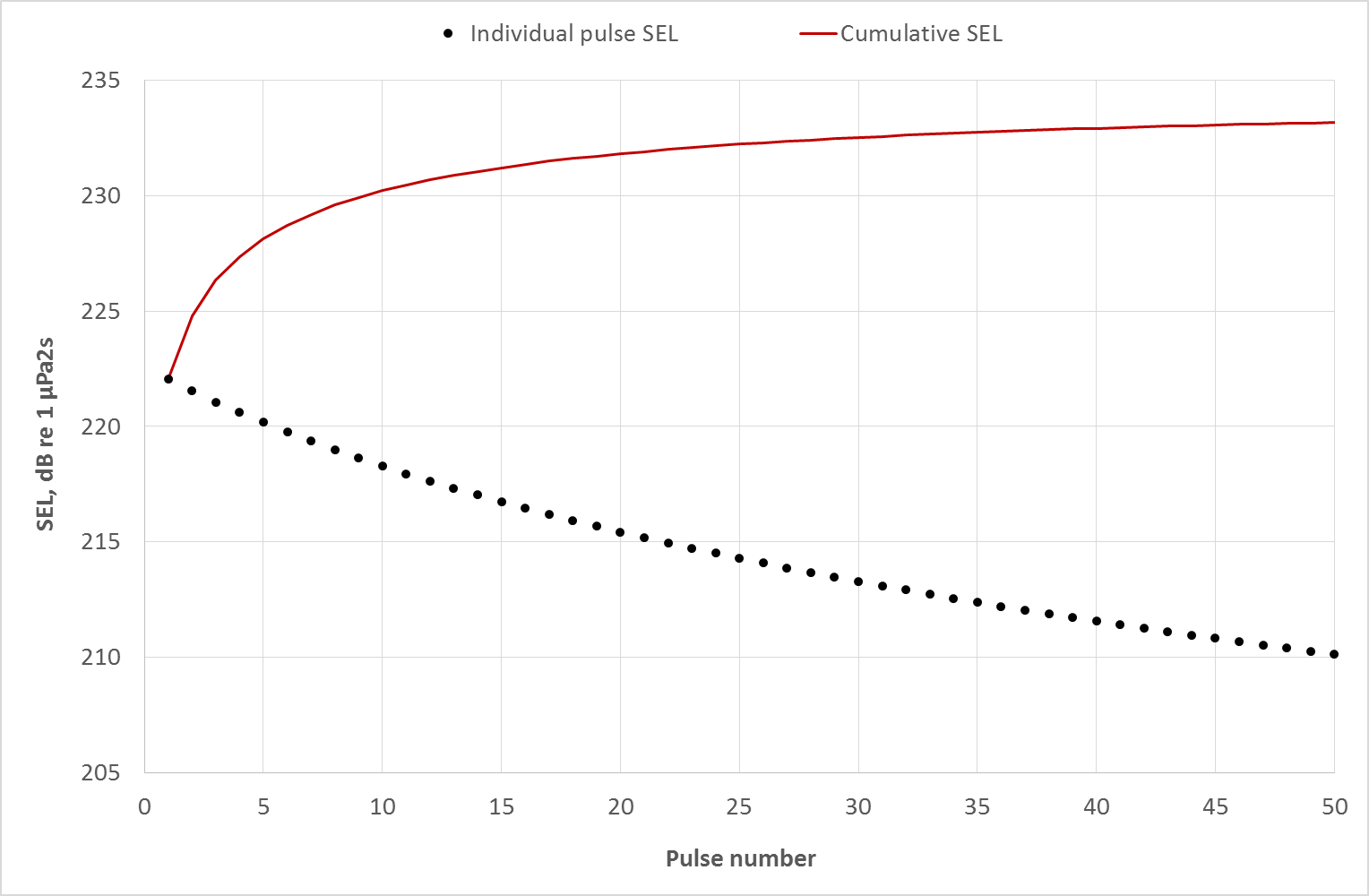5 Sound exposure calculations
As well as calculating the un-weighted instantaneous peak sound pressure levels, it is also necessary to calculate the received acoustic signal in terms of the SEL metric (where necessary and possible) for a marine mammal using the relevant hearing weighting functions. For different operations related sound sources, the numerical SEL value is equal to the SPL rms value integrated over a one second window as the sources are continuous and non-impulsive. These SEL values are employed for the calculation of cSEL (cumulative SEL) metric for different marine mammal groups to assess potential impact ranges. In the case of fish exposure, the exposure calculations are carried out using the unweighted cumulative SEL as per the threshold criteria.
Simplified exposure modelling could assume that the animal is either static and at a fixed distance away from the sound source, or that the animal is swimming at a constant speed in a perpendicular direction away from a sound source. For fixed receiver calculations, it has generally been assumed (in literature) that an animal will stay at a known distance from the sound source for a period of 24 hours. As the animal does not move, the sound will be constant over the integration period of 24 hours (assuming the source does not change its operational characteristics over this time). This, however, would give an unrealistic level of exposure, as the animals are highly unlikely to remain stationary when exposed to loud sound, and are therefore expected to swim away from the source. The approximation used in these calculations, therefore, is that the animals move directly away from the source.
It should be noted that the sound exposure calculations are based on the simplistic assumption that the sound source is active continuously (or intermittently based on source activation timings) over a 24 hour period. The real world situation is more complex. The SEL calculations presented in this study do not take any breaks in activity into account, such as repositioning of the piling vessel, and are therefore likely to be an overestimation.
Furthermore, the sound criteria described in the Southall et al. (2019) guidelines assume that the animal does not recover hearing between periods of activity. It is likely that the intervals between operations could allow some recovery from temporary hearing threshold shifts for animals exposed to the sound (Benda-Beckmann et al. 2022) and, therefore, the assessment of SEL is conservative.
In order to carry out the moving animal calculation, it has been assumed that an animal will swim away from the sound source at the onset of activities. For impulsive sounds of piledriving the calculation considers each pulse to be established separately resulting in a series of discrete SEL values of decreasing magnitude (see Figure 5.1).
Figure 5.1: A comparison of discrete SEL per pulse, and cumulative SEL values.
As an animal swims away from the sound source, the sound it experiences will become progressively lower (more attenuated); the cumulative SEL is derived by logarithmically adding the SEL to which the mammal is exposed as it travels away from the source. This calculation will be used to estimate the approximate minimum start distance for an animal in order for it not to be exposed to sufficient sound energy to result in the onset of potential auditory injury. It should be noted that the sound exposure calculations are based on the simplistic assumption that the animal will continue to swim away at a fairly constant relative speed. The real-world situation is more complex, and the animal is likely to move in a more complex manner.
The assumed swim speeds for animals likely to be present across the Ossian Marine Mammal Study area are set out in Table 5.1.
Table 5.1: Assessment swim speeds of marine mammals and fish that are likely to occur within the Irish Sea for the purpose of exposure modelling.
Species | Hearing group | Swim speed (m/s) | Source reference |
|---|---|---|---|
Harbour seal Phoca vitulina | Phocid Carnivores in Water (PCW) | 1.8 | Thompson et al. (2015) |
Grey seal Halichoerus grypus | Phocid Carnivores in Water (PCW) | 1.8 | Thompson et al. (2015) |
Harbour porpoise Phocoena phocoena | Very High Frequency (VHF) | 1.5 | Otani et al. (2000) |
Minke whale Balaenoptera acutorostrata | Low Frequency (LF) | 2.3 | Boisseau et al. (2021) |
Bottlenose dolphin Tursiops truncatus | High Frequency (HF) | 1.52 | Bailey et al. (2010) |
White-beaked dolphin Lagenorhynchus albirostris | High Frequency (HF) | 1.52 | Bailey et al. (2010) |
Short beaked common dolphin Delphinus delphis | High Frequency (HF) | 1.52 | Bailey et al. (2010) |
Risso’s dolphin Grampus griseus | High Frequency (HF) | 1.52 | Bailey et al. (2010) |
Basking shark Cetorhinus maximus | Group 1 fish | 1.0 | Sims et al. (2000) |
All fish hearing groupsa (excluding basking sharks) | Group 1 to 4 fish | 0.5 | Popper et al. (2014) |
To perform the cumulative exposure calculation, the first step is to parameterise the m-weighted sound exposure levels (or unweighted in the case of fish) for single strikes of a given energy via the 95th percentile line of best fit against the calculated received levels from the model. This function is then used to predict the exposure level for each strike in the planned hammer schedule (periods of slow start, ramp up and full power).
